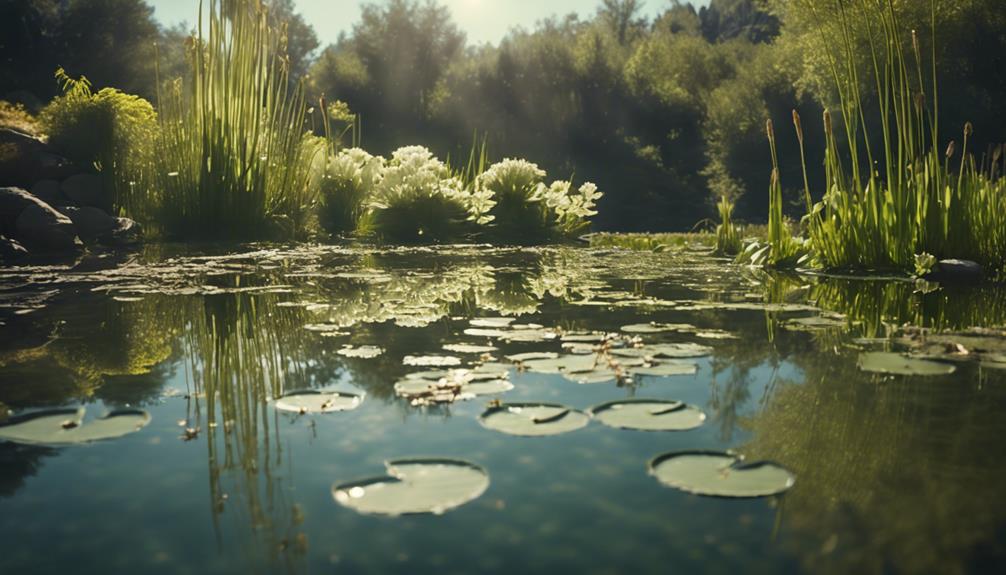You can naturally clarify your pond water with the help of aquatic plants. Three effective options are hornwort, cabomba, and anacharis. These submerged and marginal plants absorb excess nutrients, reducing the likelihood of algae growth and cloudy water. As they oxygenate the water, they create a healthy environment for other aquatic life to thrive. By incorporating these plants into your pond, you'll not only improve water clarity but also reduce the need for artificial filtration methods. As you explore the world of aquatic plants, you'll discover even more ways to harness their natural filtration power.
Table of Contents
Key Takeaways
- Aquatic plants like hornwort, cabomba, and anacharis are effective for natural water clarification in ponds and aquariums.
- Submerged plants absorb excess nutrients, reducing algae growth and cloudiness, while also producing oxygen for aquatic life.
- Regular pruning and maintenance of aquatic plants ensure their filtration capabilities remain effective and promote healthy growth.
- Aquatic plants have evolved to thrive in water, developing complex root systems that act as a natural filtration system for pond water.
- Introducing aquatic plants into a pond ecosystem creates a thriving habitat that supports a diverse range of aquatic life and maintains ecosystem balance.
Natural Filtration Powerhouses
As you explore the world of aquatic plants, you'll discover that certain species possess exceptional natural filtration capabilities, efficiently removing suspended solids, excess nutrients, and other impurities from the water.
These plants, including submerged and marginal varieties, are the unsung heroes of water clarification. They absorb nutrients, reducing the likelihood of algae growth and excess nutrients that can cloud pond water.
By oxygenating the water, they also create a healthy environment for other aquatic life to thrive.
Aquatic plants have evolved to thrive in water, developing complex root systems that act as a natural filtration system.
As water flows through the roots, impurities are trapped, and clean water is released. This process not only improves water clarity but also reduces the need for artificial filtration methods.
By incorporating these natural filtration powerhouses into your pond or water feature, you can enjoy crystal-clear water and a thriving ecosystem.
With the right selection of aquatic plants, you can harness the power of nature to maintain a balanced and healthy aquatic environment.
Benefits for Pond Ecosystems
By introducing aquatic plants into your pond ecosystem, you'll create a thriving habitat that supports a diverse range of aquatic life, from microscopic organisms to larger species. This biodiversity is essential for maintaining a balanced ecosystem, where each species plays a crucial role in maintaining water quality.
Aquatic plants provide numerous benefits, including:
| Benefit | Description | Impact on Water Quality |
|---|---|---|
| Nutrient Uptake | Plants absorb excess nutrients, preventing Algae growth | Reduces water cloudiness, clears water |
| Oxygen Production | Plants release oxygen, supporting aquatic life | Increases water clarity, supports aquatic life |
| Habitat Creation | Plants provide shelter and food for aquatic species | Supports biodiversity, maintains ecosystem balance
Easy Maintenance and Care

You'll need to establish a regular maintenance routine to guarantee your aquatic plants thrive and continue to provide effective natural water clarification.
Regular pruning and monitoring of your Pond Plants, including floating plants, are essential to prevent overcrowding and maintain a balanced ecosystem.
Overcrowding and dead foliage can negatively impact water quality, so it's vital to prune your plants regularly to promote healthy growth and maximize filtration capabilities.
Additionally, submerged plants require regular cleaning to remove debris and prevent the buildup of organic matter, which can lead to water quality issues.
To enhance plant growth and filtration, consider feeding your aquatic plants with slow-release fertilizers specifically formulated for aquatic plants.
However, be sure to follow the manufacturer's instructions to avoid over-fertilization.
By incorporating these easy maintenance practices, you'll confirm your plants help keep your water clear and clean.
Frequently Asked Questions
Can Aquatic Plants Purify Water?
You'll be fascinated to learn that aquatic plants can indeed purify water by enhancing water quality through natural filtration, removing chemicals, producing oxygen, and promoting water circulation, ultimately maintaining ecological balance in aquatic ecosystems.
What Are the Best Plants to Purify Water?
As you venture into the world of water purification, you'll find that Water Lilies, Pondweed Varieties, and Oxygenating Plants are top picks, leveraging Freshwater Algae and Nutrient Uptake to revitalize your water, making it sparkle like a gem.
What Plants Remove Bacteria From Water?
You'll find that certain plants, like Water Purifiers and Microbe Fighters, excel as Bacteria Absorbers, while others, such as Nature's Filters and Eco Warriors, work as Bio Remediators, effectively removing bacteria from water, giving you a Fresh Start.
What Plants Are Good for Natural Swimming Pools?
As you embark on creating your backyard oasis, you'll find that plants like Water Celery and Pickerelweed are perfect for natural swimming pools, enhancing pool aesthetics while providing sustainable, eco-friendly design for a safe and fun summer splash.
Conclusion
You've learned about the incredible natural filtration powerhouses that can transform your pond's water quality.
By incorporating these aquatic plants into your ecosystem, you'll reap the benefits of improved water clarity, reduced algae growth, and a healthier environment for aquatic life.
So, what's stopping you from giving your pond the gift of natural filtration?
Can you really put a price on the serenity of a crystal-clear pond?

